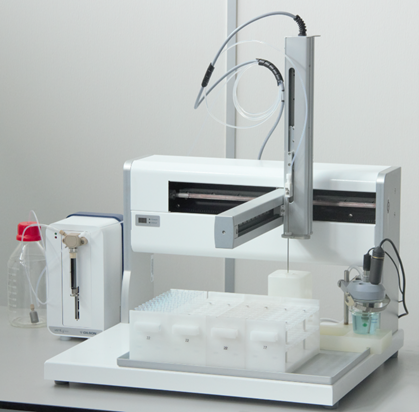Fast Reliable and cost-saving
KAPSAP (Known Addition Potentiometry, Sample Addition Potentiometry) is a fully automated workstation, which offers a unique extension of “Known Addition Potentiometry”, to determine a range of analytes using the technique of standard addition. The KAPSAP, employs unique manipulations of standard solutions, samples, and base solutions containing potentiometric sensors that can allow the fully automated Ion analysis of up to 350 samples.
The KAPSAP is perfect for water analysis and uses significantly smaller volumes than typical potentiometric titrations. This delivers an additional saving in cost and time compared to similar automated systems and also eliminates the effect of interfering ions or excess acidity/alkalinity.
Key Features
- Small sample size: 1 to 2 ml
- Capacity of up to 350 15ml samples
- The system automatically and accurately pipettes the sample. No need for manual time-consuming decanting of the sample
- Reagent savings; fluoride analysis uses 1/10 the amount of TISAB compared to conventional techniques
- KAPSAP’s procedures automatically corrects for any potential carry-over from one analysis to the next, eliminating the need to “washout” between samples
- Eliminates the problems associated with the presence of interfering ions or excess acidity / alkalinity
- Detection of <5ppm – 100% moisture


Parameter / Elements
Potentiometric titration
Ion selective electrode
Industries
Environmental
Agricutural
Use and Applications
Environmental: CN, F, S, Cl, NO3,CO2 etc., in effluents, and natural waters
Agriculture: NO3, Cl, NH4, K, Na, Ca, I, CN in soils, plant material, fertilisers, and feedstuffs
Others: Free acid in industrial processes, Control of industrial waste water, Any process with determinants including acidity, alkalinity, Br, CN, NCO, F, Cl, I, NO3, I, K, Na and HS
Standard methods
- ASTM D 1179 Standard test methods for fluoride ion in water
- ASTM D 3868 Standard test method for fluoride ions in brackish water, seawater and brines
- EPA 340.2 Fluoride (potentiometric, ion selective electrode)
- ISO 10359-1 Water quality – determination of fluoride – part 1: electrochemical probe method for potable and ightly polluted water
- SCA, Blue book 62 Fluoride in waters, effluents, sludges, plants and soils
- ASTM D 1426 Standard test methods for ammonia nitrogen in water
- ISO 6778 Water quality – determination of ammonium – potentiometric method
Product Details
Specifications
- Type of measurement: Known Addition Potentiometry, Sample Addition Potentiometry (KAPSAP) with ion selective electrode
- Capacity: 350 x 10ml disposable tubes for model GX215 / 280 x 10ml disposable tubes for model GX271
- Typical Measurement time: < 5 minutes
- Typical sample types: Potable waters, waste waters, process waters etc.
- Typical specifications (flouride): 0.005 to <100ppm of fluoride using 2.5ml of sample. Lower LODs can be achieved using more sample
- Sample volume: < 3 ml (flow through)
- Footprint: GX215 – 91.4 (w) x 61 (d) x 55.8 (h) cm
- Sample pre-treatment: The system aspirates an accurate volume of sample to reduce sample handling times.(flow through) / GX271 – 59.7 (w) x 54.1 (d) x 57.1 (h) cm
Software
The KAPSAP uses a1-envirosciences‘s highly felxible automations software TitreFAST.
PC Software:
PC specification:
- Pentium 4 with 1GHz or better, >1 GB RAM, 200GB hard disc
- Common Windows 7 64 bit interface or higher
- one free RS232 port
- Easy LIMS import of sample schedules and export via LIMS for reporting
- Windows 7 Prof 64 bit, 1024×768 or high resolution monitor
- MS Excel Reporting
- Requires Microsoft Excel or Office installed.
Calibration:
Accessories
Optional tube racks:
With over 200 standard sample racks available – virtually any tube size can be accommodated. Custom made racks are also available.

